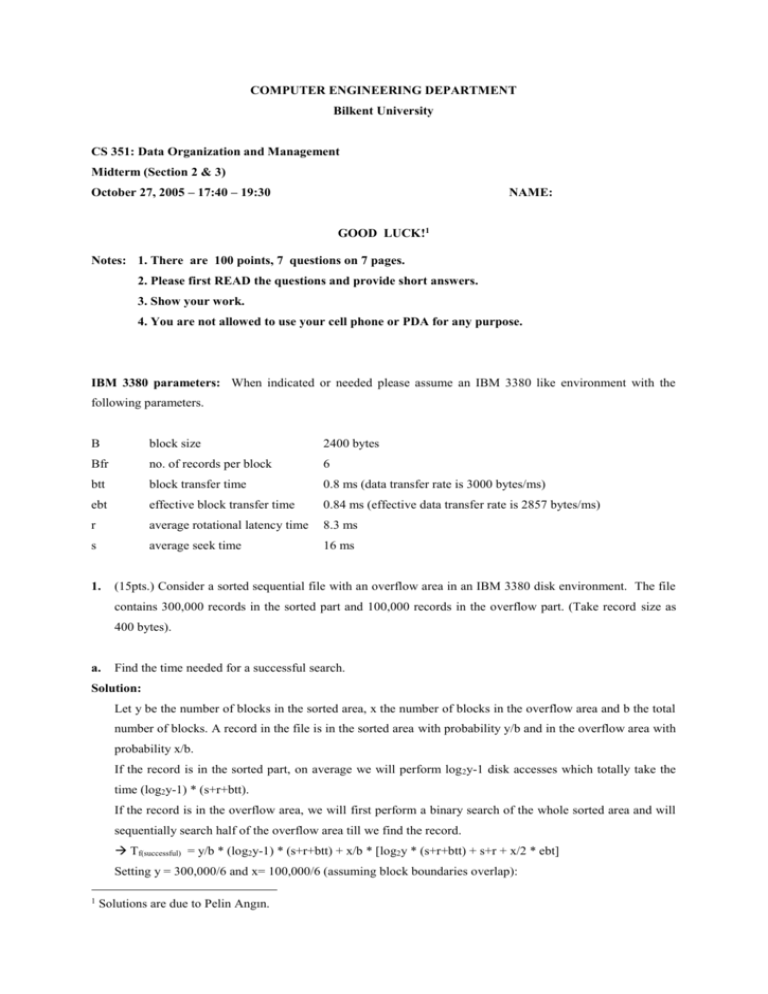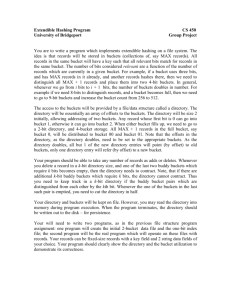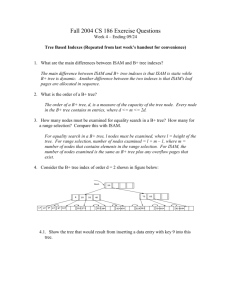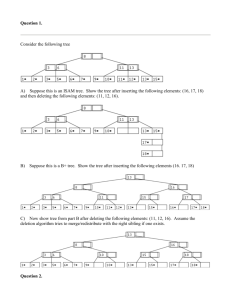Midterm exam with solutions
advertisement

COMPUTER ENGINEERING DEPARTMENT Bilkent University CS 351: Data Organization and Management Midterm (Section 2 & 3) October 27, 2005 – 17:40 – 19:30 NAME: GOOD LUCK!1 Notes: 1. There are 100 points, 7 questions on 7 pages. 2. Please first READ the questions and provide short answers. 3. Show your work. 4. You are not allowed to use your cell phone or PDA for any purpose. IBM 3380 parameters: When indicated or needed please assume an IBM 3380 like environment with the following parameters. B block size 2400 bytes Bfr no. of records per block 6 btt block transfer time 0.8 ms (data transfer rate is 3000 bytes/ms) ebt effective block transfer time 0.84 ms (effective data transfer rate is 2857 bytes/ms) r average rotational latency time 8.3 ms s average seek time 16 ms 1. (15pts.) Consider a sorted sequential file with an overflow area in an IBM 3380 disk environment. The file contains 300,000 records in the sorted part and 100,000 records in the overflow part. (Take record size as 400 bytes). a. Find the time needed for a successful search. Solution: Let y be the number of blocks in the sorted area, x the number of blocks in the overflow area and b the total number of blocks. A record in the file is in the sorted area with probability y/b and in the overflow area with probability x/b. If the record is in the sorted part, on average we will perform log 2y-1 disk accesses which totally take the time (log2y-1) * (s+r+btt). If the record is in the overflow area, we will first perform a binary search of the whole sorted area and will sequentially search half of the overflow area till we find the record. Tf(successful) = y/b * (log2y-1) * (s+r+btt) + x/b * [log2y * (s+r+btt) + s+r + x/2 * ebt] Setting y = 300,000/6 and x= 100,000/6 (assuming block boundaries overlap): 1 Solutions are due to Pelin Angın. Tf(successful) = 3 / 4 * 14.6 * 25.1+ 1 / 4 * [15.6 * 25.1 + 24.3 + 8333 * 0.84] = 2128 msec = 2.1 sec. (When logy is used instead of log2y as an approximation, the result is 1855 msec, which is very close to the original result.) b. Find the time needed for an unsuccessful search. Solution: In an unsuccessful search, we first perform a binary search in the whole sorted part and then sequentially search the whole overflow part. Tf(unsuccessful) = log2y * (s+r+btt) + s+r + x * ebt = 15.6 * 25.1 + 24.3 + 16667 * 0.84 = 14416 msec = 14 sec. 2. (15 pts.) Consider the following array representation of a priority queue (i.e., the tree structure used in heap sort): 55, 50, 70, 110, 90, 120 Draw the corresponding priority queue (tree structure). If you see something wrong please explain. Solution: The priority queue corresponding to the given array is: However, the given array (or the tree structure) does not actually represent a priority queue, as the root node has a key value greater than its left child’s (55>50) (Recall that in a priority queue each node has a key value smaller than both of its children’s) (An alternative representation formed by exchanging 50 and 55 would give us a priority queue). Redraw the following priority queue after inserting 7 and 32. Solution: In a heap, we make the insertions to the end of the corresponding array. Thus; For inserting 7: We first insert 7 as the left child of 41 and then perform the necessary exchanges to rebuild the heap structure: After inserting 7: For inserting 32: We insert 32 as the right child of 12 and the heap structure is preserved. After inserting 32: 3. (15 pts.) In an extendible hashing environment the directory level – directory depth- (d) is given as 10. In this environment the size of each directory row is given as 4 bytes. Assume that the data bucket size is 2400 bytes and the record size is 400 bytes. Answer the following questions. a) In an environment like this how many directory entries would you have (i.e., specify the number of rows in the index table)? Solution: Directory depth’s being 10 means 10 binary digits are used to distinguish the key values of the present records, thus there are 210 = 1024 directory entries (rows in the index table). b) If each directory entry requires 4 bytes what is the total size of the directory? Solution: As there are 1024 entries and each entry requires 4 bytes; total directory size is 1024*4 = 4096 bytes = 4 KB. c) What can be the maximum file size in terms of number of records? Solution: The maximum file size occurs when each row in the index table points to a separate data bucket and all the buckets are full. As the size of a bucket is 2400 bytes and that of a record is 400 bytes, in each bucket we can have 2400/400 = 6 records. As there are 1024 directory entries, the maximum number of buckets we can have is also 1024 maximum possible file size in terms number of records = 1024 * 6= 6144 records. d) In a file like this what is the minimum number of buckets with bucket depth (p) of 9? Solution: As discussed above, each entry in the index table could point to a separate data bucket in which case all buckets will have bucket depth of 10. Thus minimum number of buckets with depth 9 is zero (0). e) In a file like this what is the maximum number of buckets with bucket depth (p) of 9? Solution: As we have the directory depth 10, there should be at least two data buckets with bucket depth 10 (which hold the records that have caused a split and increased the directory depth from 9 to 10). All the remaining buckets can have bucket depth 9, which means every two entry in the index table will point one data bucket and we will have the maximum possible number of buckets with depth 9. Thus, maximum number of data buckets with bucket depth 9 = (1024 - 2) / 2 = 511. f) In a file like this what is the minimum number of buckets with bucket depth (p) of 10? Solution: As also discussed in (e), there should be at least 2 data buckets (which hold the records to have caused the split and the increase of the directory depth to 10) with bucket depth 10, to have a directory depth of 10. minimum number of data buckets with bucket depth 10 = 2. g) In a file like this what is the maximum number of buckets with bucket depth (p) of 10? Solution: The maximum number of data buckets with bucket depth 10 is 1024 (the number of entries in the index table), which occurs when each directory entry points to a separate bucket. h) In an environment like this what is the minimum and maximum I/O time to read 10 records. Assume that we keep the directory in main memory. Solution: In this question we keep in mind that we need to read whole buckets whether we want to access a single record or all records stored in a bucket. In the minimum case, we need only 2 bucket reads as 10 records can be stored at least in 2 buckets. Thus, the minimum time is 2*(s+r+dtt) = 2*25.1 = 50.2 msec. (If we assume that all records are stored consecutively, we could even ignore the s and r) In the maximum case, we need to make separate bucket accesses for each record to be read. Thus, maximum time is 10*(s+r+dtt) = 251 msec (which could even get larger if we take the maximum rotational latency ‘2r’ instead of r) 4. (14 pts.) In a linear hashing environment we have 30 primary area buckets. Bucket size is 2400 bytes and record size is 400 bytes, LF (load factor) of the file is 0.67 (or 67%). a) What is the hashing level h? Solution: The number of primary area data buckets is always between 2 h and 2h+1, as at some point in linear hashing we have all buckets hashed at the same level and then the addition of records disturbs the balance causing the split of buckets into two, with each new bucket hashed at one level more than the current hashing level (and this goes on until all the buckets are hashed at level h+1, which is when the hash level of the complete table becomes h+1). As we have 30 primary area data buckets 2h <= 30< 2h+1 24 <= 30 < 25 h = 4. b) What is the boundary value (bv)? Solution: The boundary value is the first value yet with hash level h (which is 4 in this example). As we have 14 values (as calculated in (c)) before the boundary value and we start with 0000, bv is the binary equivalent of 14 (with 4 digits) bv= 1110. c) How many primary area buckets are hashed at level h? Solution: We know that in the linear hash table we have an equal number of buckets hashed at level h+1 at the top and bottom of the hash table, as those buckets come in pairs with the ones having a ‘0’ at the beginning in the top part and those with a ‘1’ at the bottom. The buckets hashed at level h are in the middle in the hash table. Let x be the number of primary area data buckets hashed at level h, then the number of data buckets hashed at level h+1 and starting with a ‘0’ is equal to 2 4 – x (which also equals the number of those starting with a ‘1’) As we have 30 buckets as total 2*(24 – x) + x = 30 x = 2 (2 primary area buckets are hashed at level h(4)). d) How many primary area buckets are hashed at level (h+1)? Solution: As there are 2 primary area buckets hashed at level h, the remaining 30 – 2 = 28 primary area buckets are hashed at level h+1(5). e) How many records do we have in the file? Solution: As bucket size is 2400 bytes and record size is 400 bytes, each bucket can hold maximum 2400/400 = 6 records. Let M be the capacity of the primary area in terms of number of records M = 30*6 = 180. We have load factor = 0.67 = 2/3 load factor = number of records/M number of records = load factor * M = 2/3 *180 = 120 records. f) After inserting how many records does the value of bv (boundary value) change? Solution: The boundary value changes whenever we try to insert more than bucket factor * load factor number of records. As we have bucket factor = 6 and load factor 2/3 after inserting 6*2/3 = 4 records (i.e. when we try to insert the 5th record) the boundary value will change. g) In this configuration what is the minimum I/O time to access a record? Solution: The minimum access time occurs if we are able to access the desired record with a single disk access which takes s+r+dtt = 25.1 msec time. (Still better it can be if the disk head is already at the right place letting us also ignore the s (seek) and r (rotational latency )). 5. (12 pts.) Using buckets of size 3 and a hash function of mod(key, 5) and bucket chaining enter the following records (only the key values are shown) into an empty traditional hash file. Create chains of buckets when needed. 42, 57, 16, 52, 66, 77, 12, 25, 21, 33, 32, 14 Solution: Key mod(key,5) 42 2 57 2 16 1 52 2 66 1 77 2 12 2 25 0 21 1 33 3 32 2 14 4 After inserting 42, 57, 16, 52, 66: After inserting 77, 12: After inserting 25, 21, 33, 32, 14: 6. (15 pts.) Consider the following short items and respond as appropriate. a) State one advantage of the linear hashing method with respect to the extendible hashing method. Answer: Linear hashing does not require an index structure as opposed to extendible hashing. This makes it more advantageous in terms of storage. b) State one of advantage of the extendible hashing method with respect to the linear hashing method. Answer: In extendible hashing there are no overflow chains (which is possible for linear hashing), thus for each record retrieval we need to make only one disk access. So, the advantage is shorter and uniform access time. c) Is the following statement true: in dynamic hashing each record access requires just one disk access. Briefly explain your answer. Answer: The given statement is true. In dynamic hashing, we get the corresponding storage place of a record by using the index structure and when we have determined the index for a record, it is just one disk access to retrieve it (although the time to retrieve the index may not be uniform) as long as the index structure is stored in the main memory. So, if there is no situation like deferred splitting, one disk access is enough for each record access. d) In conventional hashing how can we decrease the time needed to create a hash function by changing the order of insertion of the records? Explain briefly. Answer: We can decrease the time by inserting the records in order of their hash key values. This way, as we will be entering the values in sequential order to the table, we will be saving the time used to seek the correct location to enter the record, which is performed for each entry in the random entry case. e) Consider a traditional hashing file environment that is created by bucket chaining. Assume that the bucket factor is 10 load factor is 0.8 (80%) prime data area contains 50,000 buckets the number of records stored in the prime data area is 300,000. Find the number of records stored in the overflow area Solution: Let M be the capacity of the primary data area in terms of number of records. M=50,000 * 10 = 500,000. Load factor = total number of records / M total number of records = load factor*M = 0.8 * 500,000 = 400,000 As the number of records in prime data area is 300,000 the number of records in the overflow area is 400,000 – 300,000 = 100,000 maximum possible overflow chain length that can be observed for the overflow buckets Solution: The maximum overflow chain length occurs if all the 100,000 records in the overflow area have the same hash value. As each bucket can store at most 10 records, the number of buckets needed to store 100,000 records is 100,000/10 = 10,000. Thus the maximum overflow chain length is 10,000 (in terms of buckets) expected average overflow chain length Solution: To find the average overflow chain length, we assume an equal number of chains following each bucket in the prime data area. On average we need 100,000/10 = 10,000 buckets to store the records in the overflow area. Distributing these 10,000 overflow buckets among the 50,000 buckets in the prime data area, we get average overflow chain length = 10,000/50,000 = 0.2 7. (12 pts.) Insert the records with the keys 80, 53, 26, 17, 62, 18, 35, 51 using dynamic hashing with H0(key)= mod(key, 3) and H1(key)= mod(key, 11). Assume that each bucket can hold two records. The pseudorandom bit strings to be used are defined as follows. B(0)= 1011 B(5)= 0101 B(1)= 0000 B(6)= 0001 B(2)= 0100 B(7)= 1110 B(3)=0110 B(8)= 0011 B(4)= 1111 B(9)= 0111 B(10)= 1001 Be careful and do everything right, and please do not come with complaints such as my way is correct but I used a wrong number by making a mistake during hashing. To be on the safe side first create table of hash values for the given key values as we did in our class discussions. Solution: Key H0(key) H1(key) B( H1(key)) 80 2 3 0110 53 2 9 0111 26 2 4 1111 17 2 6 0001 62 2 7 1110 18 0 7 1110 35 2 2 0100 51 0 7 1110 Initial condition: H0(key) Insert 80, 53: Insert 26: (we split as 26 would go into the same bucket as 80 and 53) Insert 17: (we split as 26 would go into the same bucket as 80 and 53) Insert 18: Insert 62: Insert 35: (we split as 35 would go into the same bucket as 80 and 53) Insert 51:





